Sustainability Assessment of Urban Public Transport for SDG Using Geospatial Big Data
Abstract
1. Introduction
2. Literature Review
3. Study Area
4. Materials and Methods
4.1. Datasets
4.2. Methods
4.2.1. Construction of the Index System
4.2.2. Kernel Density Analysis
4.2.3. Standard Deviation Elliptic Analysis
4.2.4. SDG11.2.1 Index Calculation
4.2.5. Entropy Method
4.2.6. Calculation of Public Transport Sustainability
5. Results
5.1. Analysis of Spatial Changes in Public Transportation in Guilin
5.2. The Proportion of the Population Who Can Conveniently Use the Public Transport in Guilin City
5.3. Analysis of the Sustainable Development of the Public Transportation Space in Guilin City
6. Discussion
7. Conclusions
Author Contributions
Funding
Institutional Review Board Statement
Informed Consent Statement
Data Availability Statement
Acknowledgments
Conflicts of Interest
References
- UN. Transforming Our World: The 2030 Agenda for Sustainable Development. 2015. Available online: http://www.un.org/ga/search/view_doc.asp?symbol=A/RES/70/1&Lang=E (accessed on 30 June 2022).
- Patel, Z.; Greyling, S.; Simon, D.; Arfvidsson, H.; Moodley, N.; Primo, N.; Wright, C. Local responses to global sustainability agendas: Learning from experimenting with the urban sustainable development goal in Cape Town. Sustain. Sci. 2017, 12, 785–797. [Google Scholar] [CrossRef] [PubMed]
- Guo, H.; Liang, D.; Sun, Z.; Chen, F.; Wang, X.; Li, J.; Zhu, L.; Bian, J.; Wei, Y.; Huang, L.; et al. Measuring and evaluating SDG indicators with Big Earth Data. Sci. Bull. 2022, 67, 1792–1801. [Google Scholar] [CrossRef] [PubMed]
- United Nations. THE 17 GOALS Sustainable Development. Available online: https://sdgs.un.org/goals (accessed on 7 September 2021).
- Tosun, J.; Leininger, J. Governing the interlinkages between the sustainable development goals: Approaches to attain policy integration. Glob. Chall. 2017, 1, 1700036. [Google Scholar] [CrossRef] [PubMed]
- Chidozie, F.; Oluwatobi, O.A. International organizations and global governance agenda: SDGs as a paragon. Acta Univ. Danubius. Relationes Int. 2017, 10, 43–60. [Google Scholar]
- Stafford-Smith, M.; Griggs, D.; Gaffney, O.; Ullah, F.; Reyers, B.; Kanie, N.; OConnell, D. Integration: The key to implementing the Sustainable Development Goals. Sustain. Sci. 2017, 12, 911–919. [Google Scholar] [CrossRef] [PubMed]
- Horn, P.; Grugel, J. The SDGs in middle-income countries: Setting or serving domestic development agendas? Evidence from Ecuador. World Dev. 2018, 109, 73–84. [Google Scholar] [CrossRef]
- Hosseini, K.; Stefaniec, A.; Hosseini, S.P. World Heritage Sites in developing countries: Assessing impacts and handling complexities toward sustainable tourism. J. Destin. Mark. Manag. 2021, 20, 100616. [Google Scholar] [CrossRef]
- Collste, D.; Pedercini, M.; Cornell, S.E. Policy coherence to achieve the SDGs: Using integrated simulation models to assess effective policies. Sustain. Sci. 2017, 12, 921–931. [Google Scholar] [CrossRef] [PubMed]
- Kastrinos, N.; Weber, K.M. Sustainable development goals in the research and innovation policy of the European Union. Technol. Forecast. Soc. Chang. 2020, 157, 120056. [Google Scholar] [CrossRef]
- Su, X.; Zheng, C.; Yang, Y.; Yang, Y.; Zhao, W.; Yu, Y. Spatial structure and development patterns of urban traffic flow network in less developed areas: A sustainable development perspective. Sustainability 2022, 14, 8095. [Google Scholar] [CrossRef]
- Hosseini, K.; Stefaniec, A. A wolf in sheep’s clothing: Exposing the structural violence of private electric automobility. Energy Res. Soc. Sci. 2023, 99, 103052. [Google Scholar] [CrossRef]
- Mattioli, G.; Roberts, C.; Steinberger, J.K.; Brown, A. The political economy of car dependence: A systems of provision approach. Energy Res. Soc. Sci. 2020, 66, 101486. [Google Scholar] [CrossRef]
- Huang, C.; Sun, Z.; Jiang, H.; Wang, J.; Wang, P.; Tao, J.; Liu, H.; Liu, N. Big Earth Data Supports Sustainable Cities and Communities: Progress and Challenges. Bull. Chin. Acad. Sci. 2021, 36, 9. [Google Scholar]
- Fu, B.; Zhang, J.; Wang, S.; Zhao, W. Classification–coordination–collaboration: A systems approach for advancing Sustainable Development Goals. Natl. Sci. Rev. 2020, 7, 838–840. [Google Scholar] [CrossRef]
- Allen, C.; Metternicht, G.; Wiedmann, T. Initial progress in implementing the Sustainable Development Goals (SDGs): A review of evidence from countries. Sustain. Sci. 2018, 13, 1453–1467. [Google Scholar] [CrossRef]
- Ricciolini, E.; Rocchi, L.; Cardinali, M.; Paolotti, L.; Ruiz, F.; Cabello, J.M.; Boggia, A. Assessing progress towards SDGs implementation using multiple reference point based multicriteria methods: The case study of the European countries. Soc. Ind. Res. 2022, 162, 1233–1260. [Google Scholar] [CrossRef] [PubMed]
- Pradhan, P.; Costa, L.; Rybski, D.; Lucht, W.; Kropp, J.P. A Systematic Study of Sustainable Development Goal (SDG) Interactions. Earth’s Future 2017, 5, 1169–1179. [Google Scholar] [CrossRef]
- Fonseca, L.M.; Domingues, J.P.; Dima, A.M. Mapping the sustainable development goals relationships. Sustainability 2020, 12, 3359. [Google Scholar] [CrossRef]
- McArthur, J.W.; Rasmussen, K. Classifying Sustainable Development Goal trajectories: A country-level methodology for identifying which issues and people are getting left behind. World Dev. 2019, 123, 104608. [Google Scholar] [CrossRef]
- Wang, T.; Zhang, J.; Liu, B. Evaluation index system of national innovation demonstration zones for the 2030 agenda for sustainable development. China Population. Resour. Environ. 2020, 30, 17–26. [Google Scholar]
- Fried, T.; Tun, T.H.; Klopp, J.M.; Welle, B. Measuring the Sustainable Development Goal (SDG) transport target and accessibility of Nairobi’s matatus. Transp. Res. Rec. 2020, 2674, 196–207. [Google Scholar] [CrossRef]
- Allen, C.; Nejdawi, R.; El-Baba, J.; Hamati, K.; Metternicht, G.; Wiedmann, T. Indicator-Based Assessments of Progress towards the Sustainable Development Goals (SDGs): A Case Study from the Arab Region. Sustain. Sci. 2017, 12, 975–989. [Google Scholar] [CrossRef]
- Xu, Z.; Chau, S.N.; Chen, X.; Zhang, J.; Li, Y.; Dietz, T.; Wang, J.; Winkler, J.A.; Fan, F.; Huang, B.; et al. Assessing progress towards sustainable development over space and time. Nature 2020, 577, 74–78. [Google Scholar] [CrossRef] [PubMed]
- Guo, R.; Dai, X.; Liu, L. Progress and practice in China. Eco-Econ. 2022, 38, 211–217. [Google Scholar]
- Ishtiaque, A.; Masrur, A.; Rabby, Y.W.; Jerin, T.; Dewan, A. Remote sensing-based research for monitoring progress towards SDG 15 in Bangladesh: A review. Remote Sens. 2020, 12, 691. [Google Scholar] [CrossRef]
- Bowen, K.J.; Cradock-Henry, N.A.; Koch, F.; Patterson, J.; Häyhä, T.; Vogt, J.; Barbi, F. Implementing the “Sustainable Development Goals”: Towards addressing three key governance challenges—Collective action, trade-offs, and accountability. Curr. Opin. Environ. Sustain. 2017, 26, 90–96. [Google Scholar] [CrossRef]
- Gao, F.; Zhao, X.; Song, X. Connotation and evaluation index system of beautiful China facing SDGs. Prog. Earth Sci. 2019, 34, 295–305. [Google Scholar]
- Cao, M.; Zhao, Z.; Hu, X. Measurement and Analysis of Sustainable Development Goals in Yangtze River Delta Region. Mod. Surv. Mapp. 2021, 44, 1–5. [Google Scholar]
- Yan, X.; Fan, X.; Zhang, C. Urban traffic posture prediction algorithm based on graph convolutional neural network. J. Zhejiang Uni. (Eng. Ed.) 2020, 54, 1147–1155. [Google Scholar]
- Huang, C.; Feng, Y.; Gao, F. Comprehensive assessment of SDGs in sustainable development agenda innovation demonstration zones—A case study of Lincang City. Prog. Earth Sci. 2023, 38, 987–998. [Google Scholar]
- Wei, D.; Li, W.; Yang, W.; Chen, H. Assessing the progress and spatial patterns of sustainable eco-environmental development based on the 2030 Agenda for SDGs in China. Int. J. Sustain. Dev. World Ecol. 2023, 30, 387–401. [Google Scholar] [CrossRef]
- Ma, Y.; Zhang, Z. Evaluation and influencing factor analysis of urbanization in Gansu Province under the framework of SDGs. J. Lanzhou Uni. (Nat. Sci. Ed.) 2021, 57, 627–636. [Google Scholar]
- Gao, J.; Shao, C.; Chen, S.; Wei, Z. Evaluation of sustainable development of tourism cities based on SDGs and tourism competitiveness index: Analysis of 221 prefecture-level cities in China. Sustainability 2021, 13, 12338. [Google Scholar] [CrossRef]
- Shao, C.; Gao, J.; Zhao, R. Evaluation of sustainable development of tourism-oriented cities based on SDGs and tourism competitiveness index—Taking Guilin as an example. China Pop-Resour. Environ. 2022, 32, 162–176. [Google Scholar]
- Molina-Azorín, J.F.; Font, X. Mixed methods in sustainable tourism research: An analysis of prevalence, designs and application in JOST (2005–2014). J. Sustain. Tour. 2016, 24, 549–573. [Google Scholar] [CrossRef]
- Giuliani, G.; Mazzetti, P.; Santoro, M.; Nativi, S.; van Bemmelen, J.; Colangeli, G.; Lehmann, A. From Data to Knowledge using the GEOSS platform to support Sustainable Development Goals. IOP Conf. Ser. Earth Environ. Sci. 2020, 509, 012020. [Google Scholar] [CrossRef]
- Marcinko, C.L.J.; Nicholls, R.J.; Daw, T.M.; Hazra, S.; Hutton, C.W.; Hill, C.T.; Mondal, P.P. The development of a framework for the integrated assessment of SDG trade-offs in the Sundarban Biosphere reserve. Water 2021, 13, 528. [Google Scholar] [CrossRef]
- Alves, F.L.; Da Silva, C.P.; Pinto, P. The assessment of the coastal zone development at a regional level—The case study of Portugal central area. J. Coast. Res. 2024, 50 (Suppl. S1), 72–76. [Google Scholar] [CrossRef]
- D’Adamo, I.; Gastaldi, M.; Imbriani, C.; Morone, P. Assessing regional performance for the Sustainable Development Goals inItaly. Sci. Rep. 2021, 11, 24117. [Google Scholar] [CrossRef]
- Anitescu, C.; Atroshchenko, E.; Alajlan, N.; Rabczuk, T. Artificial neural network methods for the solution of second order boundary value problems. Comput. Mater. Contin. 2019, 59, 345–359. [Google Scholar] [CrossRef]
- Purwaningsih, A.; Lubis, S.W.; Hermawan, E.; Andarini, D.F.; Harjana, T.; Ratri, D.N.; Sujalu, A.P. Moisture origin and transport for extreme precipitation over Indonesia’s new capital city, Nusantara in August 2021. Atmosphere 2022, 13, 1391. [Google Scholar] [CrossRef]
- Hatzopoulou, M.; Miller, E.J. Linking an activity-based travel demand model with traffic emission and dispersion models: Transport’s contribution to air pollution in Toronto. Transp. Res. Part D Trans. Environ. 2010, 15, 315–325. [Google Scholar] [CrossRef]
- Goldman, T.; Gorham, R. Sustainable urban transport: Four innovative directions. Technol. Soc. 2006, 28, 261–273. [Google Scholar] [CrossRef]
- Nidziy, E. Financing the construction of transport infrastructure as the basis for sustainable development of the regional economy. IOP Conf. Ser. Earth. Environ. Sci. 2017, 90, 012172. [Google Scholar] [CrossRef]
- Chen, J.; Wang, Q.; Cheng, H.; Peng, W.; Xu, W. A review of vision-based traffic semantic understanding in ITSs. IEEE Trans. Intel. Trans. Sys. 2022, 23, 19954–19979. [Google Scholar] [CrossRef]
- Sun, G.; Zhang, Y.; Liao, D.; Yu, H.; Du, X.; Guizani, M. Bus-trajectory-based street-centric routing for message delivery in urban vehicular ad hoc networks. IEEE Trans. Veh. Technol. 2018, 67, 7550–7563. [Google Scholar] [CrossRef]
- Yang, H.; Li, Z.; Qi, Y. Predicting traffic propagation flow in urban road network with multi-graph convolutional network. Complex Intel. Sys. 2024, 10, 23–35. [Google Scholar] [CrossRef]
- The State Council of the People’s Republic of China. The State Council on the Approval of the Construction of the National Sustainable Development Agenda Innovation Demonstration Zone [EB/OL]. 2018. Available online: http://www.gov.cn/zhengce/content/2018-02/24/content_5268410.htm (accessed on 1 June 2023).
- Chang, Y.; Ouyang, X.; Fei, X.; Sun, Z.; Li, S.; Jiang, H.; Li, H. Comprehensive Assessment of Sustainable Development Goal 11 at the Sub-City Scale: A Case Study of Guilin City. Remote Sens. 2023, 15, 4722. [Google Scholar] [CrossRef]
- Dong, S.; Mo, Y.; Ma, J. Research progress on ecology and sustainable development of Guilin Lijiang River Basin, China, based on bibliometric analysis. Environ. Sci. Pollut. Res. 2023, 31, 6694–6722. [Google Scholar] [CrossRef]
- Sun, Z.; Xu, R.; Du, W.; Wang, L.; Lu, D. High-resolution urban land mapping in China from sentinel 1A/2 imagery based on Google Earth Engine. Remote Sens. 2019, 11, 752. [Google Scholar] [CrossRef]
- Zhu, J.; Sun, X.; He, Z. Research on China’s sustainable development evaluation indicators in the framework of SDGs. China Popul. Resour. Environ. 2018, 28, 9–18. [Google Scholar]
- Hosseini, K.; Stefaniec, A.; O’Mahony, M.; Caulfield, B. Optimising shared electric mobility hubs: Insights from performance analysis and factors influencing riding demand. Case Stud. Transp. Policy 2023, 13, 101052. [Google Scholar] [CrossRef]
- GB 50220-95; Ministry of Construction of the People’s Republics of China. Urban Road Traffic Planning and Design Specification. China Planning Press: Beijing, China, 1995.
- Department of Construction of the People’s Republics of China. Urban Traffic Management Evaluation Index System; China Planning Press: Beijing, China, 2008. [Google Scholar]
- Zhang, N. Evaluation on Sustainable Development of Urban Passenger Transport. Master’s Thesis, Shijiazhuang Tiedao University, Shijiazhuang, China, 2014. [Google Scholar]
- Zhang, Y.; Wang, G.; Zhao, F. Research on the spatial layout of medical facilities in the main urban area of Jilin City based on GIS. Geo Inf. 2024, 22, 48–51. [Google Scholar]
- Hu, J.; Yu, J.; Zhang, C. A study on the spatial distribution of China’s aid to Africa based on standard deviation ellipse. World Geo. Res. 2024, 3, 79–88. Available online: http://kns.cnki.net/kcms/detail/31.1626.P.20240123.1056.002.html (accessed on 15 April 2024).
- Brussel, M.; Zuidgeest, M.; Pfeffer, K.; van Maarseveen, M. Access or Accessibility? A Critique of the Urban Transport SDG Indicator. ISPRS Int. J. Geo Inf. 2019, 8, 67. [Google Scholar] [CrossRef]
- Zhang, C.; Sun, Z.; Xing, Q.; Sun, J.; Xia, T.; Yu, H. Localizing indicators of SDG11 for an integrated assessment of urban sustainability—A case study of Hainan province. Sustainability 2021, 13, 11092. [Google Scholar] [CrossRef]
- Xu, W.; Su, Y.; Li, H.; Wang, S.; Jiang, X.; Ma, J. Evaluation of Bus Station Layouts in Transportation Hub Based on Entropy Weight Method. J. Transp. Syst. Eng. Inf. Technol. 2023, 23, 104–112. [Google Scholar]
- Chu, Y. Research on sustainable Development of Urban Public Transportation in Changsha City. Master’s Thesis, Changsha University of Science and Technology, Changsha, China, 2013. [Google Scholar]
- Cai, D. Study on Sustainable Development of Urban Public Transport-Take Chongqing City. Ph.D. Thesis, Chongqing Jiaotong University, Chongqing, China, 2010. [Google Scholar]
- Han, L.; Lu, L.; Lu, J.; Liu, X.; Zhang, S.; Luo, K.; He, D.; Wang, P.; Guo, H.; Li, Q. Assessing Spatiotemporal Changes of SDG Indicators at the Neighborhood Level in Guilin, China: A Geospatial Big Data Approach. Remote Sens. 2022, 14, 4985. [Google Scholar] [CrossRef]
- Ji, X.; Zhang, H.; Chen, F. The evaluation model of the priority development degree of public transportation based on the element extension model of entropy weight. J. Kunming Univ. Sci. Technol. (Nat. Sci. Ed.) 2013, 38, 32–38. [Google Scholar]
- Wang, P.; Wang, B.; Xu, B.; Huang, Y.; Gao, F.; Zhao, X.; Huang, C.; Song, X.; Zhou, L. Progress and prospect of sustainable development goals in underdeveloped mountainous areas. Adv. Earth Sci. 2022, 37, 937–948. [Google Scholar]
- Tiznado-Aitken, I.; Muñoz, J.C.; Hurtubia, R. The Role of Accessibility to Public Transport and Quality of Walking Environment on Urban Equity: The Case of Santiago de Chile. Transp. Res. Rec. 2018, 2672, 129–138. [Google Scholar] [CrossRef]
- Zhang, X. Research on the Optimization of the “Bus Priority” Policy in Small and Medium-Sized Cities. Ph.D. Thesis, Nanjing University of Science and Technology, Nanjing, China, 2021. [Google Scholar]
- Wu, J. Reflections on Urban Public Transportation and Urban Development. Transp. World 2021, 35, 4–5. [Google Scholar]
- Leyk, S.; Gaughan, A.E.; Adamo, S.B.; de Sherbinin, A.; Balk, D.; Freire, S.; Pesaresi, M. The spatial allocation of population: A review of large-scale gridded population data products and their fitness for use. Earth Sys. Sci. Data 2019, 11, 1385–1409. [Google Scholar] [CrossRef]
- Gan, L. Quantitative Evaluation of SDGs Sustainable Development Framework of SDGs in Chengdu-Chongqing Economic Circle. Master’s Thesis, Chongqing Normal University, Chongqing, China, 2021. [Google Scholar]
- Klopp, J.M.; Petretta, D.L. The urban sustainable development goal: Indicators, complexity and the politics of measuring cities. Cities 2017, 63, 92–97. [Google Scholar] [CrossRef]
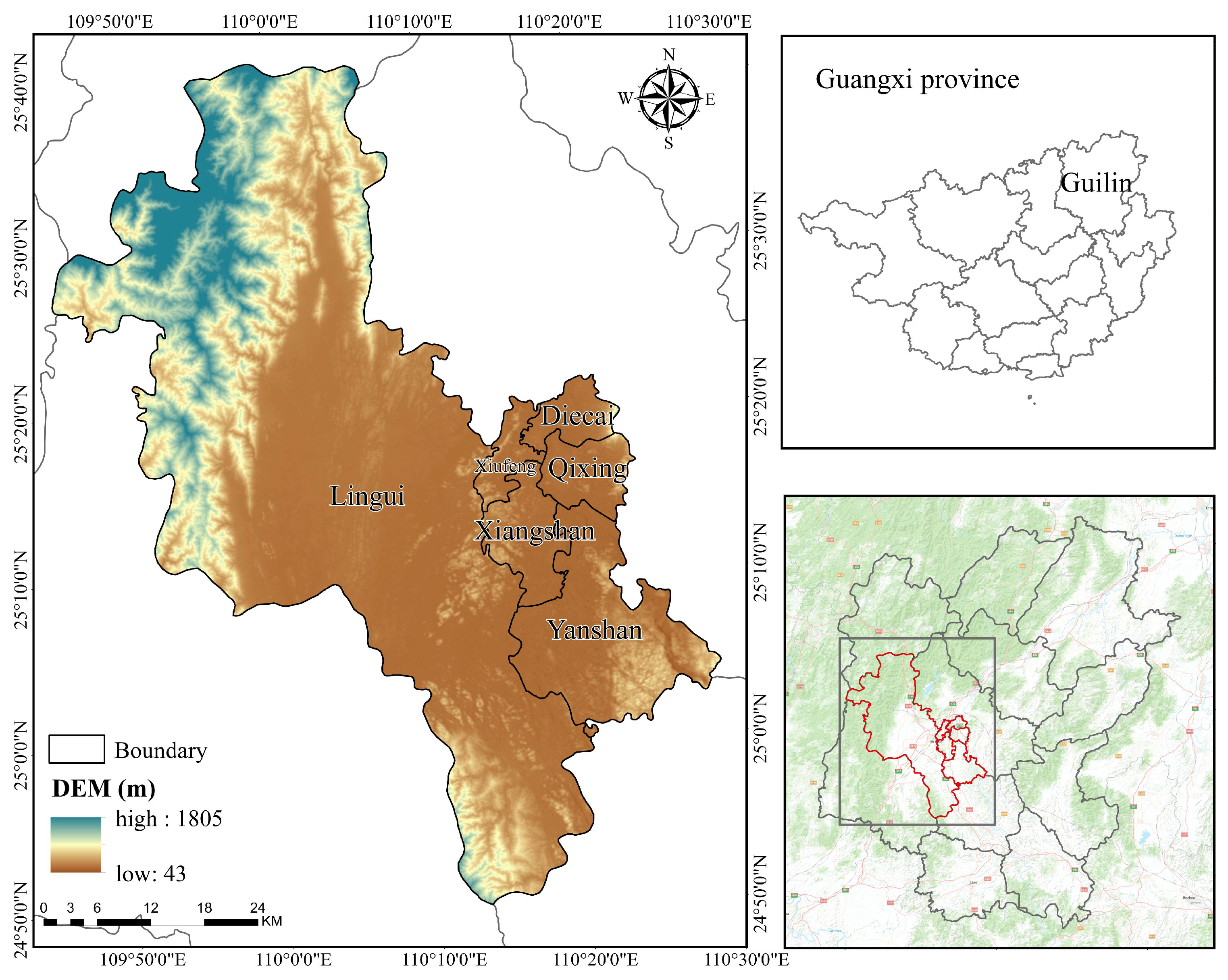

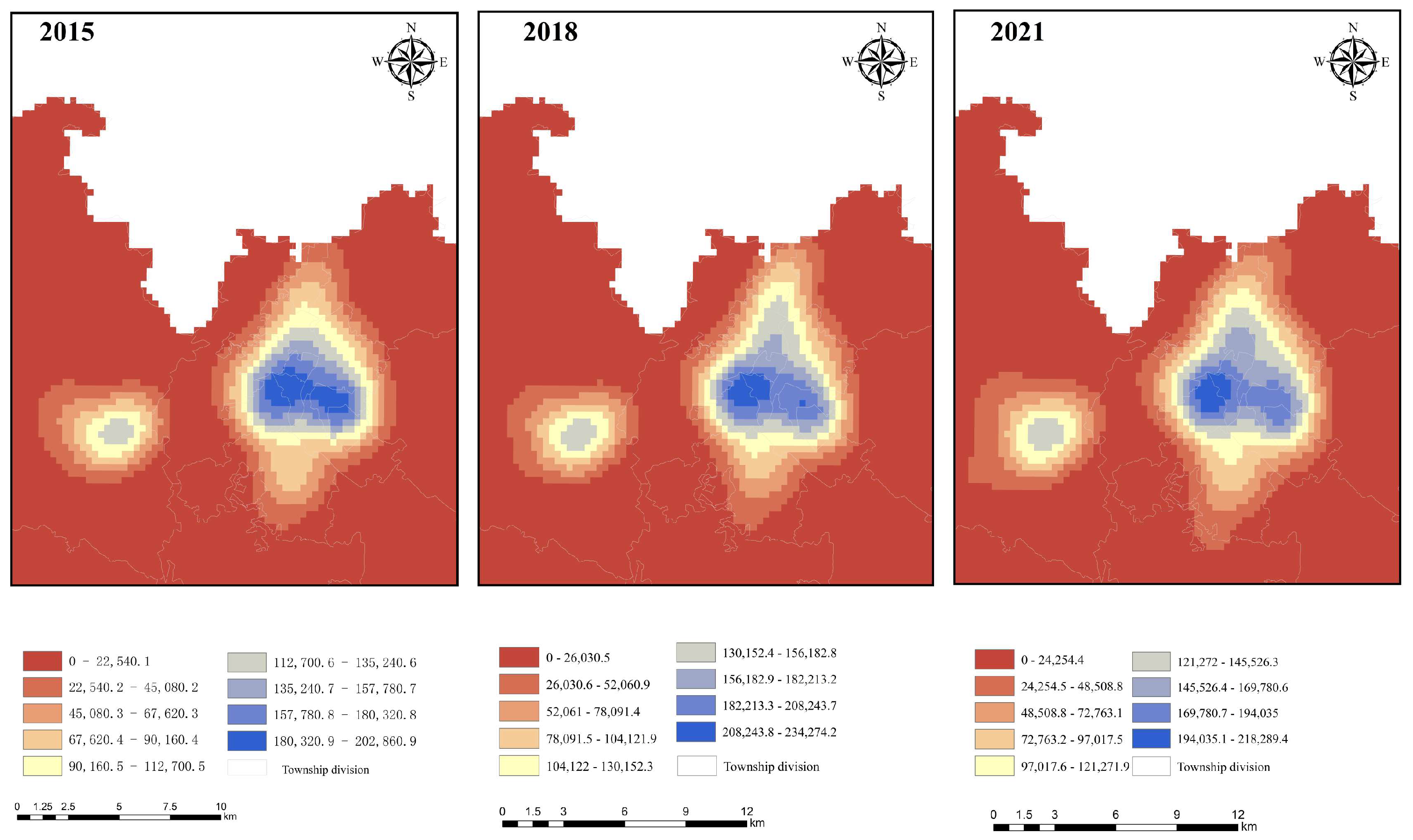

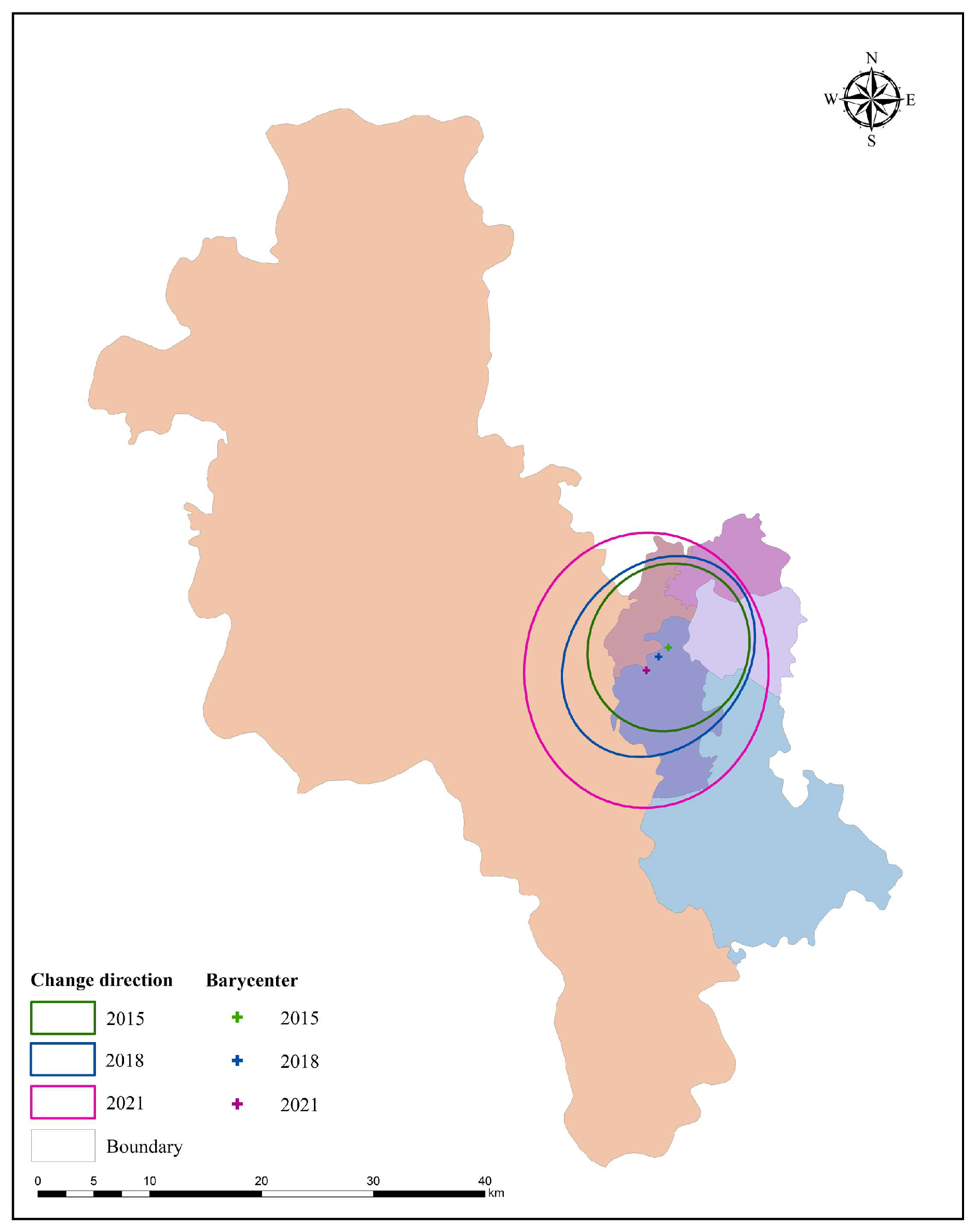
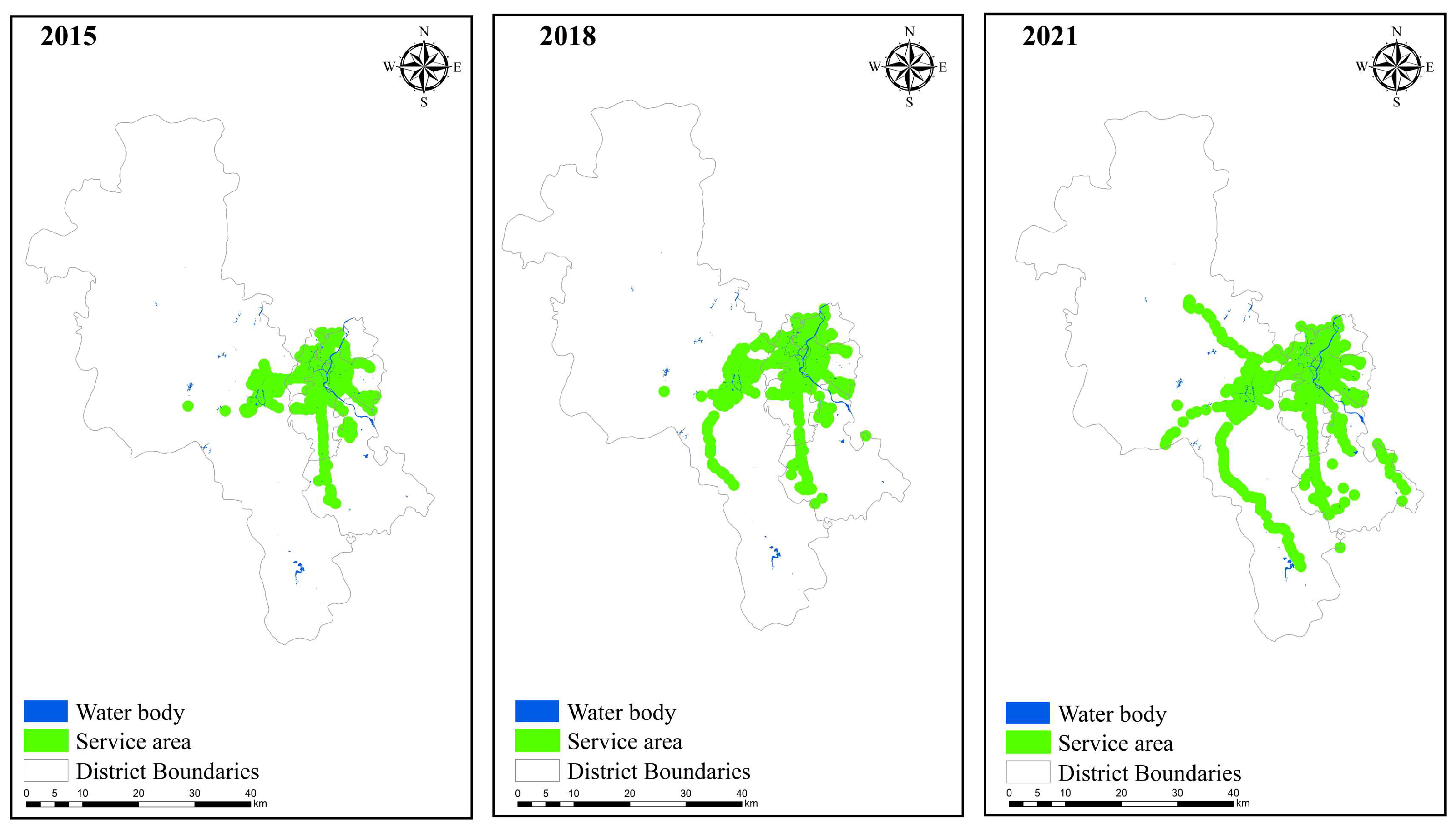
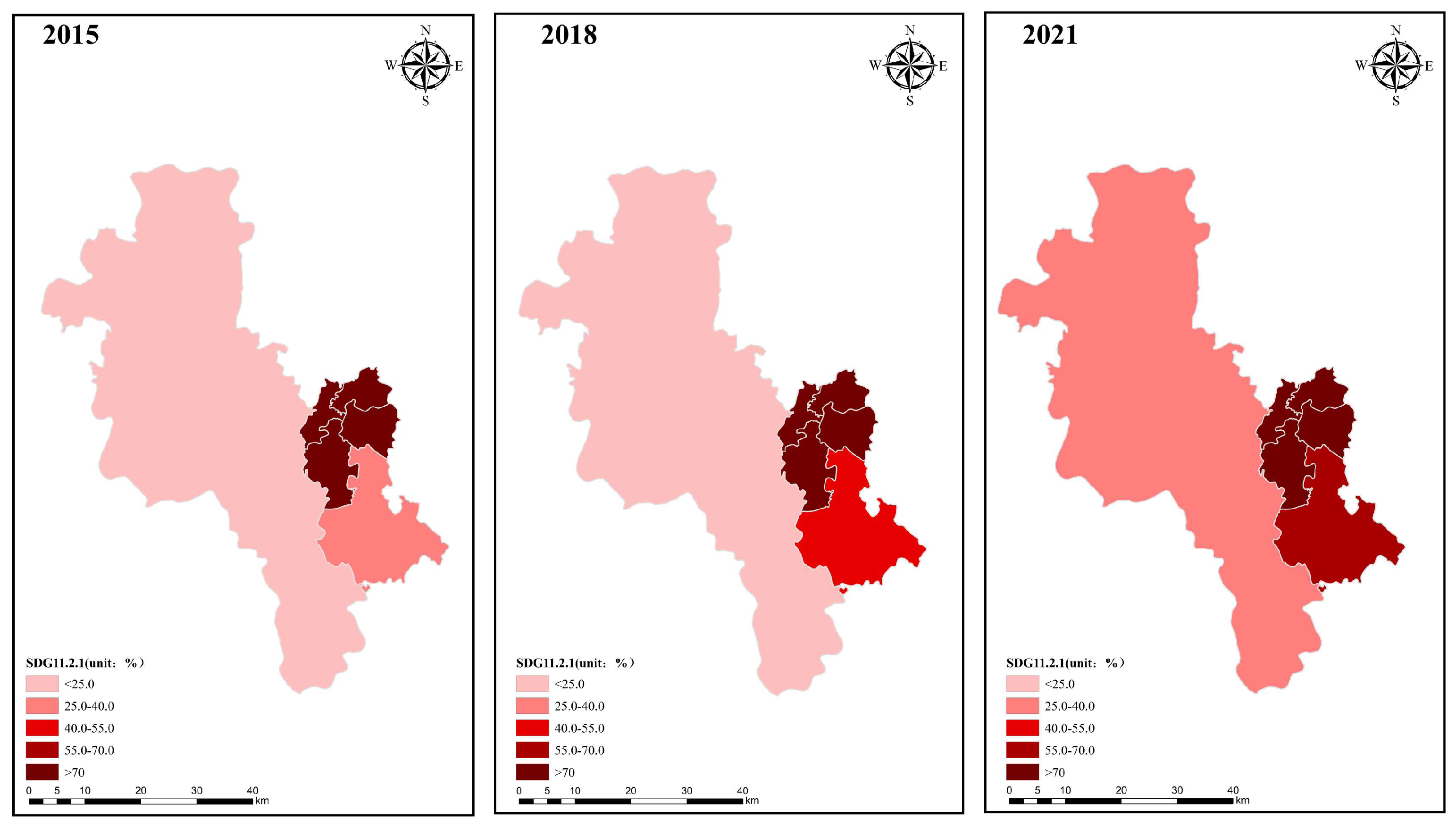

| Evaluation Indicator | Unit | Attribute | Definition | SDG Indicator |
|---|---|---|---|---|
| Bus network density | km/km2 | + | Refers to the total length of bus routes divided by land area of the city served by bus. | 11.2.1 |
| Share of new energy buses | % | + | Ratio of new energy public transport vehicles to total public transport vehicles. | 11.2.1 |
| Bus entry rate | % | + | Refers to the proportion of the number of parked vehicles occupied on the road outside the starting point and terminal area of public transport to the total number of public transport vehicles. | 11.2.1 |
| Bus share rate | % | + | Refers to the ratio of trips made by urban residents who choose public transportation as a mode of travel to the total number of trips made. | 11.2.1 |
| Average distance between bus stops | km | − | Refers to the ratio of the total length of city bus routes to the total number of stops. | 11.2.1 |
| Public transportation priority policy | term | + | According to the characteristics of the city itself, the strategy of priority development of public transport and the matching urban public passenger transport regulations are formulated. | 11.2.1 |
| Average speed of public transportation | km/h | + | Refers to the average speed between the first and last stations of the line (including the driving time among the stations and the stop time of each station) except for the travel length. | 11.2.1 |
| Proportion of population within a radius of 500 m, a walkable distance [55] | % | + | Refers to the ratio of the population within 500 m of a bus stop to the total urban population | 11.2.1 |
| Number of public transportation vehicles available per 10,000 people | Vehicle | + | Refers to the number of marked buses per 10,000 people in a certain space in the city | 11.2.1 |
| GDP growth rate | % | + | Refers to the rate of urban GDP increase in that year compared with the previous year | 11.2.1 |
| Evaluation Indicator | [90, 100] | 80, 90) | 70, 80) | 60, 70) | 0, 60) |
|---|---|---|---|---|---|
| Bus network density | [3, 4] | 2.5, 3) | 2, 2.5) | 1.5, 2) | 0, 1.5) |
| Share of new energy buses | ≥90 | 60, 90) | 30, 60) | 10,30) | <10 |
| Bus entry rate | ≥90 | 80, 90) | 70, 80) | 60,70) | 0, 60) |
| Bus share rate | [35, 40] | 30, 35) | 25, 30) | 20, 25) | 0, 20) |
| Average distance between bus stops | [500, 600] | 600, 700) | 700, 800) | 800, 1000) or 300, 500) | >1000 or <300 |
| Public transportation priority policy | Meet eight items | Meet seven items | Meet six items | Meet five items | Less than five items |
| Average speed of public transportation | [25, 30] | 22, 25) | 19, 22) | 16, 19) | 0, 16) |
| Proportion of population within a radius of 500 m, a walkable distance | ≥90 | 80, 90) | 70, 80) | 60, 70) | 0, 60) |
| Number of public transportation vehicles available per 10,000 people | ≥16 | 14, 16) | 12, 14) | 8, 12) | 0, 8) |
| GDP growth rate | ≥8 | 6, 8) | 4, 6) | 2, 4) | <2 |
| Comprehensive Index | [0–60] | [60–70] | [70–80] | [80–90] | >90 |
|---|---|---|---|---|---|
| Development level | Unsustainable development | Low sustainable development | Medium sustainable development | Good sustainable development | Very good sustainable development |
| Evaluation Indicator | Entropy Value | Diversity Factor | Weight |
|---|---|---|---|
| Bus network density | 0.9993 | 0.0007 | 0.0033 |
| Share of new energy buses | 0.9624 | 0.0376 | 0.1653 |
| Bus entry rate | 0.9999 | 0.0134 | 0.0004 |
| Bus share rate | 0.9916 | 0.0084 | 0.0370 |
| Average distance between bus stops | 0.9987 | 0.0013 | 0.0056 |
| Public transportation priority policy | 0.9205 | 0.0795 | 0.3493 |
| Average speed of public transportation | 0.9968 | 0.0032 | 0.0140 |
| Proportion of population within a radius of 500 m, a walkable distance | 0.9934 | 0.0066 | 0.0291 |
| Number of public transportation vehicles available per 10,000 people | 0.9423 | 0.0577 | 0.2536 |
| GDP growth rate | 0.9676 | 0.0324 | 0.1424 |
| Total | 1 |
| Evaluation Indicator | Final Score in 2015 | Final Score in 2021 |
|---|---|---|
| Bus network density | 0.3026 | 0.3106 |
| Share of new energy buses | 12.7083 | 14.3759 |
| Bus entry rate | 0.0411 | 0.0420 |
| Bus share rate | 2.2254 | 2.5894 |
| Average distance between bus stops | 0.2836 | 0.3352 |
| Public transportation priority policy | 19.2135 | 26.2003 |
| Average speed of public transportation | 0.7871 | 1.0658 |
| Proportion of population within a radius of 500 m, a walkable distance | 2.0080 | 2.1984 |
| Number of public transportation vehicles available per 10,000 people | 13.9506 | 16.6139 |
| GDP growth rate | 12.7785 | 10.7496 |
| Total | 64.30 | 74.48 |
Disclaimer/Publisher’s Note: The statements, opinions and data contained in all publications are solely those of the individual author(s) and contributor(s) and not of MDPI and/or the editor(s). MDPI and/or the editor(s) disclaim responsibility for any injury to people or property resulting from any ideas, methods, instructions or products referred to in the content. |
© 2024 by the authors. Licensee MDPI, Basel, Switzerland. This article is an open access article distributed under the terms and conditions of the Creative Commons Attribution (CC BY) license (https://creativecommons.org/licenses/by/4.0/).
Share and Cite
Zhang, Q.; Liu, C.; Lu, L.; Hu, J.; Chen, Y. Sustainability Assessment of Urban Public Transport for SDG Using Geospatial Big Data. Sustainability 2024, 16, 4542. https://doi.org/10.3390/su16114542
Zhang Q, Liu C, Lu L, Hu J, Chen Y. Sustainability Assessment of Urban Public Transport for SDG Using Geospatial Big Data. Sustainability. 2024; 16(11):4542. https://doi.org/10.3390/su16114542
Chicago/Turabian StyleZhang, Qinghua, Chuansheng Liu, Linlin Lu, Jangling Hu, and Yu Chen. 2024. "Sustainability Assessment of Urban Public Transport for SDG Using Geospatial Big Data" Sustainability 16, no. 11: 4542. https://doi.org/10.3390/su16114542
APA StyleZhang, Q., Liu, C., Lu, L., Hu, J., & Chen, Y. (2024). Sustainability Assessment of Urban Public Transport for SDG Using Geospatial Big Data. Sustainability, 16(11), 4542. https://doi.org/10.3390/su16114542








